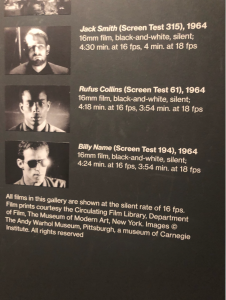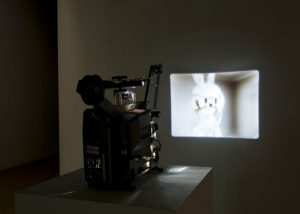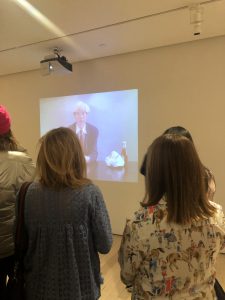 Andy Warhol: Screen Test 315, 61, 194
Andy Warhol: Screen Test 315, 61, 194
Andy Warhol’s pieces at the Whitney really surprised me. I found myself getting sucked in each time a film was playing. There was something so odd and entertaining about them. I wrote originally about Andy Warhol eating a burger which was very captivating. I can’t explain why but there was just something about It. However, while I was at the Whitney more of Andy’s work pulled me in. Some, in particular, was his screen tests. The Screen Tests are a series of short, silent, black-and-white film portraits, made between 1964 and 1966, generally showing the subjects from the neck up against plain backdrops.
What I found interesting about the films was how simple they were but also how complex. First off the lighting is set up to be harsh on the subject. It creates huge shadows and bright highlights. Secondly, the subject stands really still either looking directly in the camera or off to the side for a total of 3 mins. I did not learn that the projected movie was shown in slow motion as well which added to this uneasy feeling I got from watching the films.
I also felt like I was watching one of his paintings. The famous Marilyn Monroe painting, for example, was in my head when watching these films. I think it’s because the subject sits center in the frame from the neck up just like the paintings. I’m not sure if Andy was going with that but I wouldn’t doubt It. As I watched the screen tests I also was reminded of mug shots. The movie looked like moving mug shots to me and later when I did my research on the films I learned that Andy based this work off of the New York City Police Department booklet entitled The Thirteen Most Wanted. I found that interesting because I really felt like these could be mug shots. Another thing these films reminded me of was a horror movie. I felt like something scary was going to happen almost like a jump scare. They felt like old school horror movies because of the lighting and emphasis on shadows and highlights.
Andy shot these films on 16mm film, black and white. These films were silent and about 3-5 mins long at 18fps. I think he did a great job with them because even though they were only single shots of peoples portraits I found It very interesting and captivating. Watching It in a dark small theater helped too because I felt like I was watching something special outside of the exhibit. The environment added to the experience. The only thing I would have changed was the couple making out in front of me but I guess that can be part of a movie-going experience. All in all, I had a wonderful time at the Whitney and watching Andy’s films was eye-opening and a great experience.
 Mark Leckey Made in ‘Eaven
Mark Leckey Made in ‘Eaven